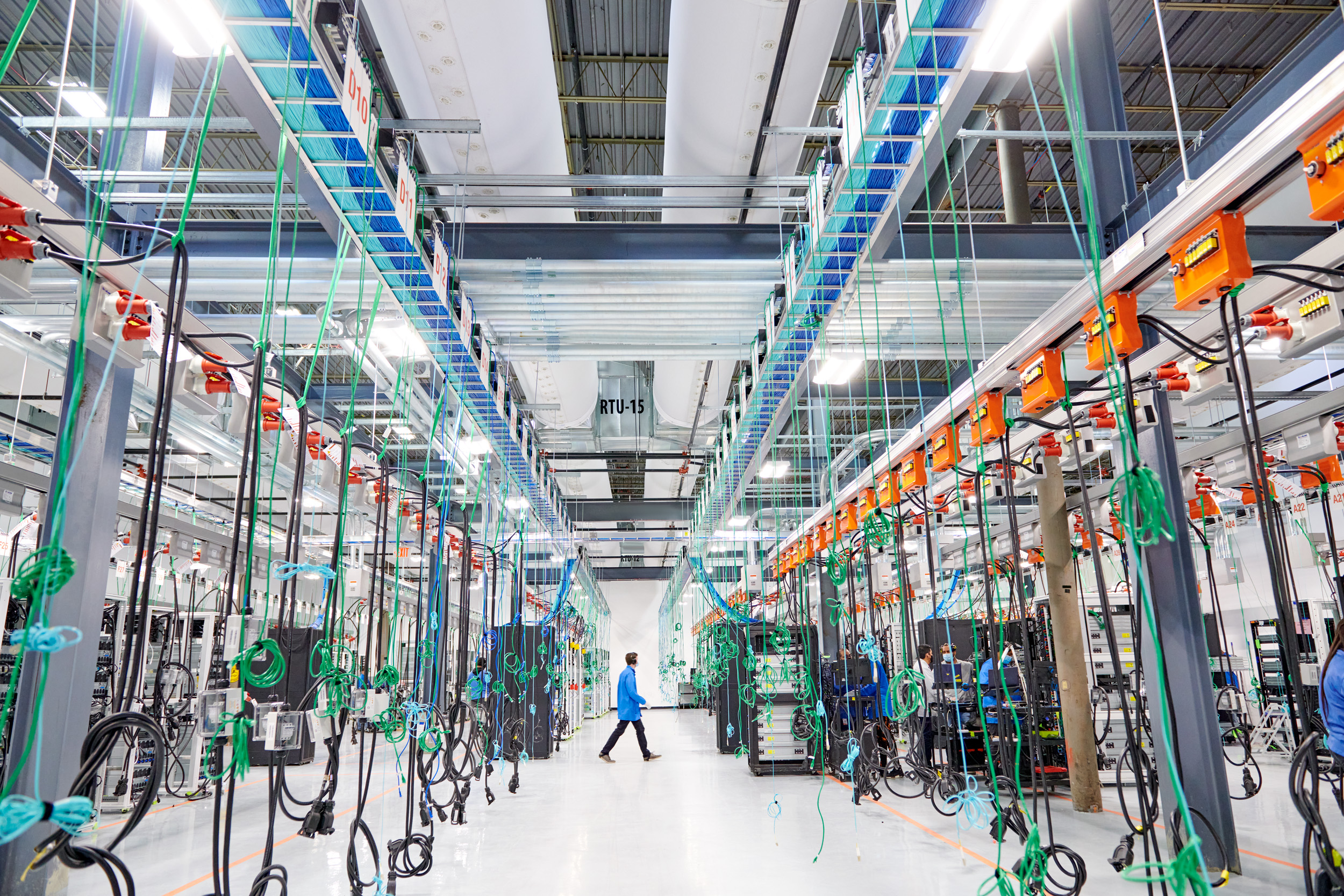AMD has completed its acquisition of ZT Systems, a move that marks a significant step in the AI infrastructure market. This deal will help AMD create new end-to-end AI solutions that combine their CPUs, GPUs, and networking technology with ZT Systems’ expertise. The acquisition positions AMD to capture part of the growing $500 billion AI market while enhancing their cloud computing capabilities.
The company sees this purchase as strategic for building comprehensive AI infrastructure. AMD had been working with several potential partners before finalizing the deal with ZT Systems. The U.S.-based data center infrastructure that ZT Systems provides will now become part of AMD’s expanding AI technology portfolio.
This acquisition shows how important AI has become in the tech industry’s competitive landscape. By bringing ZT Systems under its umbrella, AMD can now offer more complete solutions to customers looking to implement or expand their AI capabilities.

Why AMD’s Acquisition of ZT Systems Matters
The $4.9 billion acquisition of ZT Systems isn’t just another buyout—it’s a major strategic move in the race for AI infrastructure dominance. With this deal, AMD gains a vital foothold in the hyperscale market, giving it end-to-end capabilities to deliver full-stack solutions to companies like Microsoft, Meta, and other cloud giants that are rapidly scaling their AI infrastructure.
ZT Systems has been somewhat of a quiet powerhouse in the background—designing, engineering, and delivering custom server solutions at scale. By bringing ZT’s system-level design and manufacturing capabilities in-house, AMD can now tightly integrate its CPUs, GPUs, FPGAs, and adaptive SoCs into vertically optimized platforms tailored for AI workloads.
Let’s break down how this deal transforms AMD’s position in the market.
Key Benefits of the Deal for AMD
| Benefit | Description |
|---|---|
| Vertical Integration | AMD now controls more of the supply and production chain, improving time-to-market and customization for clients. |
| Deeper Hyperscale Ties | ZT’s existing relationships with Microsoft, AWS, Meta, and Google bolster AMD’s already growing AI portfolio. |
| Faster AI Infrastructure Deployment | AMD will be able to deliver rack-scale solutions optimized for specific AI workloads using their own silicon. |
| Talent Acquisition | Over 1,000 engineers from ZT Systems will join AMD’s Data Center Solutions team, strengthening in-house expertise. |
The Bigger Picture: Competing in the AI Arms Race
The market for AI infrastructure is exploding. Nvidia has dominated the space with its GPU-driven systems, but AMD is closing the gap by combining powerful compute hardware with system-level customization. Acquiring ZT Systems gives AMD a faster path to deliver complete AI factory solutions—racks of compute nodes with pre-validated AMD hardware.
AI Infrastructure Market Trends
| Year | Estimated Market Size (AI Hardware & Infrastructure) |
|---|---|
| 2023 | $58.5 Billion |
| 2024 | $87.3 Billion |
| 2025 (est.) | $125 Billion |
| 2026 (est.) | $170 Billion |
Sources: IDC, Gartner, internal estimates
This market acceleration is driven by LLM training, inference workloads, and generative AI tools used across every industry—from search to social media to autonomous systems.
How This Affects AMD’s Hyperscale Customers
ZT Systems has long been a go-to white-label provider for hyperscale data centers, delivering high-volume, customized racks for giants like Meta. With AMD now in control of that capability, hyperscalers can expect tighter silicon-to-system alignment and faster turnaround for next-gen AI platforms.
This means:
- Reduced deployment times for new AI training clusters
- Better performance-per-watt from AMD-powered systems
- Optimized thermal and power delivery for high-density compute nodes
- Pre-integrated rack-scale solutions with AMD EPYC, Instinct, and adaptive SoCs
What Happens to ZT’s Manufacturing Business?
Interestingly, AMD has already stated it’s exploring “strategic alternatives” for ZT’s U.S.-based manufacturing facilities. This suggests AMD wants to retain the design and integration expertise while potentially outsourcing or spinning off the physical manufacturing operations—keeping their focus on high-value engineering and system optimization.
This could result in:
- Streamlined operations with less CapEx burden
- Partnerships with contract manufacturers for physical builds
- Faster pivoting as AI workloads and hardware needs evolve

The Battlefront: AMD vs Nvidia vs Intel
AMD’s acquisition puts them in a better position to challenge Nvidia, which still dominates the AI market thanks to its CUDA ecosystem and high-performance GPU systems. But AMD has been steadily gaining ground with:
- MI300X GPUs for high-performance AI
- EPYC processors with massive core counts
- Pensando SmartNICs and adaptive compute via Xilinx
Now, with ZT Systems, AMD can offer the complete rack—from chip to server to software optimization. Intel, meanwhile, is still lagging in terms of AI GPU capabilities and has struggled to get Gaudi into the mainstream.
Here’s a quick comparison of the current AI infrastructure stack:
| Company | Compute | Custom Racks | Hyperscale Penetration | Software Ecosystem |
|---|---|---|---|---|
| Nvidia | H100, H200 | Yes (DGX, HGX) | High | CUDA, Triton |
| AMD | MI300X, EPYC | Now Yes (via ZT) | Growing | ROCm |
| Intel | Gaudi, Xeon | Limited | Moderate | OpenVINO |
What Analysts Are Saying
“This acquisition changes the calculus for AMD. They now control not just the silicon, but how it’s deployed at scale for AI. That’s a huge competitive edge.”
— Patrick Moorhead, Moor Insights & Strategy
“ZT was the secret supplier behind a lot of hyperscale infrastructure. Now AMD gets those relationships and that agility.”
— Karl Freund, Cambrian-AI Research
Final Notes on the Strategy
AMD’s acquisition of ZT Systems signals a new phase in the battle for AI infrastructure dominance. It’s no longer just about having the best chip—it’s about who can deliver optimized, full-stack systems to hyperscale partners at speed. And with this move, AMD has made itself a far more serious contender.
Key Takeaways
- AMD’s acquisition of ZT Systems enables new end-to-end AI solutions combining CPU, GPU and networking technologies.
- The deal helps AMD target the $500 billion AI market with enhanced cloud computing capabilities.
- ZT Systems’ U.S.-based data center infrastructure strengthens AMD’s competitive position in the AI technology space.
Details of the Acquisition
AMD completed its acquisition of ZT Systems for $4.9 billion, enhancing its capabilities in cloud computing and AI infrastructure. This strategic move positions AMD to compete more effectively in the growing AI market.
Strategic Implications
The acquisition lets AMD create end-to-end AI solutions by combining its CPU, GPU, and networking silicon with ZT Systems’ expertise in data-center equipment design. This integration will help AMD deliver more comprehensive AI infrastructure offerings to compete with other tech giants.
ZT Systems brings valuable expertise in systems design specifically for cloud computing and AI applications. The partnership enables AMD to build what they call a “new class” of AI solutions, leveraging open-source technologies alongside their hardware.
AMD aims to capture a larger share of the AI market, estimated to be worth $500 billion. The company can now offer both the chips and the complete systems they power, making it a more attractive partner for companies building AI infrastructure.
Financial Aspects
The $4.9 billion transaction represents a significant investment for AMD but positions them to compete in the high-growth AI infrastructure market. This acquisition follows the industry trend of chip makers expanding their offerings to include complete systems.
The deal helps AMD diversify its revenue streams beyond traditional CPU and GPU sales. By moving up the value chain to offer complete systems, AMD potentially increases its profit margins and creates new sales opportunities.
AMD expects this acquisition to be accretive to non-GAAP financial metrics. The combined expertise should help AMD win contracts with Fortune 500 companies and cloud providers who need specialized AI computing solutions.
The investment reflects AMD’s confidence in the continued growth of AI infrastructure spending, particularly in high-performance computing and data center applications.
Impact on Industry and Future Integration
AMD’s acquisition of ZT Systems marks a significant shift in the AI infrastructure landscape. This $4.9 billion deal combines AMD’s silicon prowess with ZT’s system-building expertise to create new opportunities for data centers and AI deployment.
Advancing Data Center Capabilities
The merger positions AMD to deliver more complete solutions for modern data centers. By integrating ZT Systems’ infrastructure expertise with AMD’s CPU, GPU, and networking technologies, the company can now offer optimized rack-scale systems tailored for AI workloads.
AMD can now compete more effectively with rivals by providing end-to-end solutions rather than just components. This integration helps data centers deploy AI systems more efficiently, reducing implementation barriers.
For hyperscale providers, this means access to customized hardware stacks optimized specifically for their workloads. Enterprise customers benefit from pre-configured systems that simplify the complex process of building AI infrastructure.
The combined company will likely focus on power efficiency—a critical factor as AI deployments grow larger and energy concerns mount.
Enhancing the AI Ecosystem
The acquisition strengthens AMD’s position in the AI market by adding ZT Systems’ practical implementation experience to AMD’s silicon design expertise. This combination should accelerate innovation in inferencing solutions, where AMD has been working to gain market share.
Open-source software will play a key role in the integration strategy. AMD’s ROCm platform can now be more tightly integrated with hardware configurations, creating a more seamless experience for developers.
The deal enables AMD to offer solutions across the entire AI stack—from chips to full systems. This vertical integration helps customers implement AI more easily while potentially reducing costs.
For the broader industry, this acquisition signals a trend toward consolidation among technology providers seeking to offer comprehensive AI solutions rather than individual components.
Better networking technologies will likely emerge from this partnership, addressing the growing demands of distributed AI training workloads.
Frequently Asked Questions
AMD’s acquisition of ZT Systems brings significant changes to the AI and cloud computing landscape. The deal creates new opportunities for technological advancement and market competition.
What are the strategic reasons behind AMD’s acquisition of an AI infrastructure company?
AMD acquired ZT Systems to strengthen its position in the AI market. The move helps AMD compete with other chipmakers like Nvidia and Intel.
ZT Systems brings expertise in AI and cloud computing infrastructure. This knowledge will help AMD create better end-to-end AI solutions.
The acquisition also gives AMD access to ZT’s existing customer relationships in the cloud computing space.
How will AMD’s acquisition of an AI infrastructure company impact its position in the semiconductor market?
The acquisition boosts AMD’s capabilities in the growing AI chip market. AMD can now offer more complete solutions that combine CPUs, GPUs, and networking components.
This helps AMD compete more effectively against Nvidia, which has dominated the AI chip market.
ZT Systems’ expertise allows AMD to better understand customer needs and design chips specifically for AI workloads.
What potential synergies are expected to result from AMD’s latest acquisition?
The combination of AMD’s silicon technology and ZT Systems’ infrastructure expertise creates powerful synergies. Together they can develop optimized AI systems that work better than separate components.
AMD can now offer both hardware and implementation expertise. This makes it easier for customers to deploy AMD technology.
The companies can share research and development resources to create more innovative products faster.
What regulatory approvals are required for AMD’s purchase of an AI infrastructure company?
AMD needed approval from competition authorities in several jurisdictions. These include the U.S. Federal Trade Commission and possibly European regulators.
The deal required review to ensure it wouldn’t create unfair market conditions or reduce competition.
Based on the search results, AMD has completed the acquisition, indicating all necessary regulatory approvals were obtained.
How does the acquisition fit into AMD’s overall business strategy?
The ZT Systems acquisition aligns with AMD’s focus on expanding its data center business. It helps AMD tap into the estimated $500 billion AI market opportunity.
ZT Systems now operates under AMD’s Data Center Solutions business unit. This unit is led by Executive Vice President Forrest Norrod.
The move shows AMD’s commitment to becoming a full-service provider of AI and cloud computing solutions rather than just a chip supplier.
What are analysts saying about the long-term effects of the AMD acquisition on the AI technology sector?
Analysts view this acquisition as a strategic move that could help AMD challenge Nvidia’s dominance. The combined expertise makes AMD a more credible competitor in AI infrastructure.
Some experts believe this acquisition will accelerate innovation in AI hardware and solutions. The increased competition could lead to better products and potentially lower prices.
Analysts expect AMD to leverage ZT Systems’ knowledge to develop more specialized AI products that better meet customer needs.







